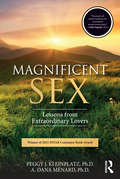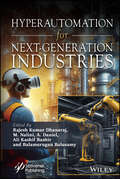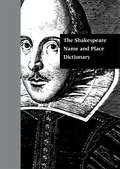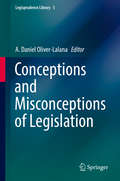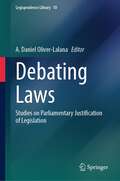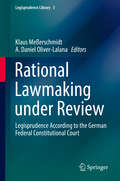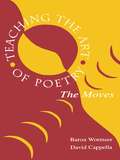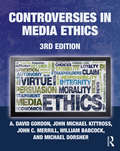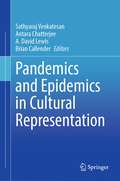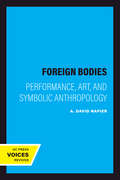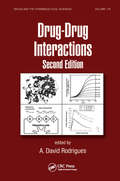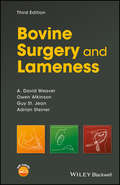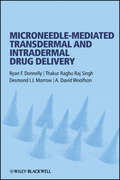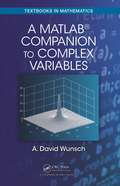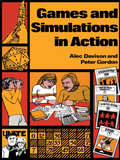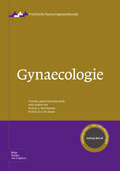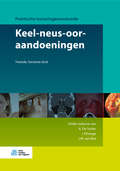- Table View
- List View
Magnificent Sex: Lessons from Extraordinary Lovers
by Peggy J. Kleinplatz A. Dana MénardWhat makes sex magnificent? What are the qualities of extraordinary erotic intimacy and what are the elements that help to bring it about? Is great sex the stuff that people remember nostalgically from the "honeymoon" phase of their relationships, or can sex improve over time? Magnificent Sex is based on the largest, in-depth interview study ever conducted with people who are having extraordinary sex. It gathers the nuggets for remarkable sex from the "experts", distilling them into an attainable blueprint for ordinary lovers who want to make erotic intimacy grow over the course of a lifetime. Looking at factors including individual and relational qualities, empathic communication and the myths and realities of magnificent sex, this book offers accessible and evidence-based guidance for lovers and therapists alike. It is replete with frank and often humorous interviews with straight and LGBTQ individuals and couples, those who are "vanilla" and "kinky", monogamous and consensually non-monogamous and healthy and chronically ill. This illuminating book explores the implications of the findings to develop a model that effectively tackles the common problems of low desire and frequency. The "cure" for low desire is to create desirable sex!
Hyperautomation for Next-Generation Industries
by Balamurugan Balusamy Ali Kashif Bashir Rajesh Kumar Dhanaraj M. Nalini A. DanielThis book is essential for anyone looking to understand how hyperautomation can revolutionize businesses by simplifying operations, reducing errors, and creating more intelligent and adaptable workplaces through the use of automation technologies such as artificial intelligence, machine learning, and robotic process automation. The use of automation technologies to simplify any and every activity conceivable in a business, allowing repeated operations to operate without manual intervention, is known as hyperautomation. Hyperautomation transforms current and old processes and equipment by utilizing artificial intelligence, machine learning, and robotic process automation. This digital transformation may assist a business in gaining cost and resource efficiency, allowing it to prosper in a more competitive environment. With the advancement of automation technologies, hyperautomation is becoming more prevalent. Companies are shifting their methods to create more human-centered and intelligent workplaces. This change has ushered in a new era for organizations that rely on technology and automation tools to stay competitive. Businesses may move beyond technology’s distinct advantages to genuine digital agility and scale adaptability when all forms of automation operate together in close partnership. Automation tools must be simple to incorporate into the current technological stack while not requiring too much effort from IT. A platform must be able to plug and play with a wide range of technologies to achieve hyperautomation. The interdependence of automation technologies is a property that is connected to hyperautomation. Hyperautomation saves individuals time and money by reducing errors. Hyperautomation has the potential to create a workplace that is intelligent, adaptable, and capable of making quick, accurate decisions based on data and insights. Model recognition is used to determine what to do next and to optimize processes with the least amount of human engagement possible.
The Shakespeare Name and Place Dictionary
by A. Daniel Frankforter J. Madison DavisEntries provide the likely sources for a name; describe historical and mythological backgrounds; examine Shakespeare's presentation of a character or place; and suggest various interpretations of a name. Each entry contains line citations to William Shakespeare: The Complete Works, edited by Wells and Taylor, Oxford University Press, 1986.
Conceptions and Misconceptions of Legislation (Legisprudence Library #5)
by A. Daniel Oliver-LalanaThis volume brings together an international group of legal scholars to discuss different approaches to lawmaking. As well as reflecting the diversity of legisprudence as a re-emerging academic field, it offers a broad overview of current developments and challenges in the theory of legislation, and aspires, moreover, to counterbalance some questionable ideas or misconceptions, widespread among jurists, on what making laws entails. The book is organized into three parts. The first comprises a sample of ‘ways and models of legislation’, ranging from classic legislative ideals to contemporary forms of regulation. The essays in this part, variances of focus notwithstanding, revolve around the notions of legislative rationality, quality, effectiveness, and legitimacy, which may be regarded as the cornerstones of legisprudence. Interwoven with these notions is another core legisprudential concern: the justification of laws. We address it separately in the next part by exploring the connection between lawmaking, argumentation and constitutional democracy: under the heading ‘legislation in a culture of justification’, a number of aspects of this connection are tackled that have not been sufficiently considered so far in legisprudential literature, such as the intricacies of legislative reasoning and balancing, or the justificatory problems posed by special-interest legislation. The under privileged status of legisprudence in legal studies and the need for socially attentive and citizen-oriented legislative research come to the fore in the third part of the book which turns to the relationships between ‘legisprudence, lawyers, and citizens’. All in all, the thirteen articles gathered here provide a stimulating insight into the theory of legislation, and can hopefully contribute to the reconciliation of the study of law and the study of its making.
Debating Laws: Studies on Parliamentary Justification of Legislation (Legisprudence Library #10)
by A. Daniel Oliver-LalanaThis book seeks to explore the potential and actual value of parliamentary debates as a source of legislative justification. Drawing on a sample of recent Spanish legislation, the papers collected here analyse (critically) the rationale of several laws or legislative measures as it can be reconstructed from the respective parliamentary discussions. All issues covered have given rise to intense political, legal and social controversy: they range from the combat against gender violence, the legal status of bullfighting, the protection of crime victims and the so-called ‘push-backs’ at the border, to the regulation of euthanasia, the minimum living income, underage girls’ access to abortion, and joint child custody. The volume is organised into two main parts. The first group of case studies adopt a legisprudential perspective and examine parliamentary deliberations in the light of the theory and methodology of legislative justification; the contributions in the second part follow approaches that fall outside – but are largely compatible with –legisprudence, and deal with aspects such as the rhetorical strategies employed by MPs when debating bills, and the role of elected legislators as constitutional interpreters.
Rational Lawmaking under Review
by A. Daniel Oliver-Lalana Klaus MeßerschmidtThis book explores the constitutional, legally binding dimension to legisprudence in the light of the German Federal Constitutional Court´s approach to rational lawmaking. Over the last decades this court has been remarkably active in applying legisprudential criteria and standards when reviewing parliamentary laws. It has thus supplied observers with a unique material to analyse the lawmakers' duty to legislate rationally, and to assess the virtues and drawbacks of this strand of judicial control in a constitutional democracy. By bringing together legislation experts and public law scholars to elaborate on 'legisprudence under review', this contributed volume aspires to shed light on the constitutionalisation of rational lawmaking as a controversial trend gaining ground in both national and international jurisdictions. The book is divided into five parts. Part I frames the two key issues pervading the whole collection: the intricate relationship between judicial review and democracy, on the one hand, and the possibility of improving and rationalizing the task of legislation under the current circumstances of politics, on the other. Part II provides an overview of the judicial review of rational lawmaking, laying special emphasis on the duty of legislative justification imposed on lawmakers by the German Constitutional Court. Part III is devoted to the review of the systemic rationality of legislation, in particular to the requirements of legislative consistence and coherence as developed by this court. Contributions in Part IV revolve around the judicial scrutiny of the socio-empirical elements of rational lawmaking, with the control of legislative facts and impacts and the problem of symbolic laws being the central topics. Finally, Part V draws on the German case law to discuss the links between rational lawmaking, balancing and proportionality, and the interdependence between process review and substantive review of legislation.
The Rationality and Justification of Legislation: Essays in Legisprudence
by Luc J. Wintgens A. Daniel Oliver-LalanaThe essays collected in this book address legislation from the viewpoint of legal theory and provide an overview of current research in legisprudence as a new scholarly approach to lawmaking. The overall focus of the volume is on the justification of legislation, with a special emphasis on the intricate notion of legislative rationality. With the rational justification of legislation as their central theme, the essays elaborate on the foundations and bounds of legislation and the search for a more principled lawmaking, discuss the role of legislation within the framework of democratic constitutionalism, analyze legislation as implementation of constitutional law, and explore how legislative argumentation in parliament can be construed as a source of justification of laws.
Teaching the Art of Poetry: The Moves
by Baron Wormser A. David CappellaConcise and accessible, this guide to teaching the art of poetry from Shakespeare to contemporary poets enables anyone to learn about how poets approach their art. Teachers can use this book to explore any facet or era of poetry. Any reader can use it as an entryway into the art of poetry. Teaching the Art of Poetry shows poetry as a multi-faceted artistic process rather than a mystery on a pedestal. It demystifies the art of poetry by providing specific historical, social, and aesthetic contexts for each element of the art. It is a nuts-and-bolts approach that encourages teachers and students to work with poetry as a studio art--something to be explored, challenged, assembled and reassembled, imagined, and studied--all the things that an artist does to present poetry as a search for meaning. This book advocates poetry as an essential tool for aesthetic, cultural, and linguistic literacy. It portrays poetry as an art rather than a knowledge base, and methods for integrating the art of poetry into the school curriculum. The authors' intention is not to fill gaps; it is to change how poetry is presented in the classroom, to change how it is taught and how students think about it. Teaching the Art of Poetry: * Emphasizes hands-on experiences. Over 160 exercises focus attention on the dynamics of the art of poetry. Activities include group work, peer editing, critical thinking skills, revising drafts, focused reading, oral communication, listening skills, and vocabulary, as well as mechanics and usage. * Features a week-long lesson plan in each chapter to aid the teacher. These relate the main aspects of each chapter to classroom activities and, in addition, include a "Beyond the Week" section to promote further investigation of the topic. * Promotes an integrated approach to poetry. The examples used in each chapter show poetry as a living tradition. * Makes extensive use of complete poems along with extracts from many others. * Does not talk down to teachers--is teacher oriented and jargon free.
Neonatal Neural Rescue: A Clinical Guide
by Joseph J. Volpe A. David Edwards Denis V. Azzopardi Alistair J. GunnWorldwide more than one million babies die annually from perinatal asphyxia and its associated complications such as neonatal encephalopathy - one of the major causes of cerebral palsy and cognitive deficiencies in children aside from prematurity. Cooling the head - or the entire body - minimizes neuronal death, enabling the neonatal brain to be 'rescued' thus greatly improving developmental outcomes. Hypothermic neural rescue therapy has revolutionized the treatment of this condition and is a major recent achievement in neonatal medicine. This landmark book provides a brief scientific underpinning of hypothermic neural rescue therapy and lays out the evidence base for good practice. Internationally recognized authorities give practical advice, drawn from personal experience, on how to deliver hypothermia in the neonatal intensive care unit. A valuable addition to any neonatal unit, this is essential reading for neonatologists, neonatal nurses and paediatric neurologists.
Controversies in Media Ethics
by John Michael Kittross Michael Dorsher A. David Gordon William Babcock John C. MerrillControversies in Media Ethics offers students, instructors and professionals multiple perspectives on media ethics issues presenting vast "gray areas" and few, if any, easy answers. This third edition includes a wide range of subjects, and demonstrates a willingness to tackle the problems raised by new technologies, new media, new politics and new economics. The core of the text is formed by 14 chapters, each of which deals with a particular problem or likelihood of ethical dilemma, presented as different points of view on the topic in question, as argued by two or more contributing authors. The 15th chapter is a collection of "mini-chapters," allowing students to discern first-hand how to deal with ethical problems. Contributing authors John A. Armstrong, Peter J. Gade, Julianne H. Newton, Kim Sheehan, and Jane B. Singer provide additional voices and perspectives on various topics under discussion. This edition has been thoroughly updated to provide: discussions of issues reflecting the breadth and depth of the media spectrum numerous real-world examples broad discussion of confidentiality and other timely topics A Companion Website (www.routledge.com/textbooks/9780415963329) supplies resources for both students and instructors. You can also join the Controversies community on Facebook: http://www.facebook.com/CME3rd Developed for use in media ethics courses, Controversies in Media Ethics provides up-to-date discussions and analysis of ethical situations across a variety of media, including issues dealing with the Internet and new media. It provides a unique consideration of ethical concerns, and serves as provocative reading for all media students.
American Comics, Literary Theory, and Religion
by A. David LewisUnlocking a new and overdue model for reading comic books, this unique volume explores religious interpretations of popular comic book superheroes such as the Green Lantern and the Hulk. This superhero subgenre offers a hermeneutic for those interested in integrating mutiplicity into religious practices and considerations of the afterlife.
Pandemics and Epidemics in Cultural Representation
by A. David Lewis Sathyaraj Venkatesan Antara Chatterjee Brian CallenderThis edited book analyses how artists, authors, and cultural practitioners have responded to and represented episodes of epidemics/pandemics through history. Covering a broad range of notable epidemics/pandemics (black death, cholera, Influenza, AIDS, Ebola, COVID-19), the chapters examine the cultural representations of epidemics and pandemics in different contexts, periods, languages, media, and genres. Interdisciplinary in nature and drawing on perspectives from medicine, literature, medical anthropology, philosophy of medicine, and cultural theory, the book investigates and emphasizes the urgent need to reflect on past catastrophes caused by such outbreaks. By delving into cultural history, it re-examines how societies and communities have responded in the past to species-threatening epidemics/pandemics. Sure to be of interest to lay readers as well as students and researchers, this work situates epidemics and pandemics outbreaks within the contexts of culture and narrative, and their complex and layered representation, commenting on intersections of contagion, culture, and community. It offers a cross-cultural, global, and comparative analysis of the trajectories, histories and responses to various epidemics/pandemics that impacted people worldwide.
Critical Care of the Stroke Patient
by Stefan Schwab Daniel Hanley A. David Mendelow Stefan Schwab Daniel HanleyNew and groundbreaking therapeutic options for the critical care of patients with cerebrovascular disease have improved patient management, minimized morbidity, reduced in-patient care, improved quality of life, and had a positive economic impact on health service provision. This volume integrates these approaches and suggests the best therapy option for all cerebrovascular conditions. The early chapters of the book focus on monitoring techniques and interventions. Subsequent sections address the critical care of a wide range of cerebrovascular diseases: ischemic stroke, intracranial hemorrhage, subarachnoid hemorrhage, arteriovenous malformations, cerebral venous thrombosis and traumatic injury. The editors and authors are internationally recognized experts in their field, and the text is supplemented by tables and illustrations to demonstrate important clinical findings. This book will meet the needs of stroke physicians, neurologists, neurosurgeons, neurointensivists and interventional neuroradiologists seeking to maximize positive outcomes for their patients.
The Cambridge Companion to T. S. Eliot
by A. David MoodyAn international team of leading T. S. Eliot scholars contribute studies of different facets of the writer's work to build up a carefully coordinated and fully rounded introduction. Five chapters give a complete account of Eliot's poems and plays, while others assess the major aspects of his life and thought. Later chapters place his work in historical perspective. There is a full review of Eliot studies, and a useful chronological outline. Taken as a whole, this Companion comprises an essential handbook for students and readers of T. S. Eliot.
Foreign Bodies: Performance, Art, and Symbolic Anthropology
by A. David NapierIn five wide-ranging essays, A. David Napier explores the ways in which the foreign becomes literally and metaphorically embodied as a part of cultural identity rather than being seen as something outside it. Pre-classical Greece, Baroque Italy, and Western postmodernism are among the artistic domains Napier considers, while the symbolic terrain ranges from Balinese cosmography to body symbolism in biomedicine.
Changing How We Choose: The New Science of Morality
by A. David RedishThe &“new science of morality&” that will change how we see each other, how we build our communities, and how we live our lives.In Changing How We Choose, David Redish makes a bold claim: Science has &“cracked&” the problem of morality. Redish argues that moral questions have a scientific basis and that morality is best viewed as a technology—a set of social and institutional forces that create communities and drive cooperation. This means that some moral structures really are better than others and that the moral technologies we use have real consequences on whether we make our societies better or worse places for the people living within them. Drawing on this new scientific definition of morality and real-world applications, Changing How We Choose is an engaging read with major implications for how we see each other, how we build our communities, and how we live our lives.Many people think of human interactions in terms of conflicts between individual freedom and group cooperation, where it is better for the group if everyone cooperates but better for the individual to cheat. Redish shows that moral codes are technologies that change the game so that cooperating is good for the community and for the individual. Redish, an authority on neuroeconomics and decision-making, points out that the key to moral codes is how they interact with the human decision-making process. Drawing on new insights from behavioral economics, sociology, and neuroscience, he shows that there really is a &“new science of morality&” and that this new science has implications—not only for how we understand ourselves but also for how we should construct those new moral technologies.
Drug-Drug Interactions: Progress And Future Challenges (Drugs And The Pharmaceutical Sciences Ser.)
by A. David RodriguesAuthored by renowned leaders in the field, this comprehensive volume covers all aspects of drug-drug interactions, including preclinical, clinical, toxicological, and regulatory perspectives.Thoroughly updated, this second edition reflects the significant advances and includes extensive new material on:key interplay between transporters and enzymes
Enzyme- and Transporter-Based Drug-Drug Interactions
by A. David Rodrigues Raimund M. Peter K. Sandy PangGermination of the thought of "Enzymatic- and Transporter-Based Drug-Drug Interactions: Progress and Future Challenges" Proceedings came about as part of the annual meeting of The American Association of Pharmaceutical Scientists (AAPS) that was held in San Diego in November of 2007. The attendance of workshop by more than 250 pharmaceutical scientists reflected the increased interest in the area of drug-drug interactions (DDIs), the greater focus of PhRMA, academia, and regulatory agencies, and the rapid pace of growth in knowledge. One of the aims of the workshop was to address the progress made in quantitatively predicting enzyme- and transporter-based DDIs as well as highlighted areas where such predictions are poor or areas that remain challenging for the future. Because of the serious clinical implications, initiatives have arisen from the FDA (http://www.fda.gov/cber/gdlns/interactstud.htm) to highlight the importance of enzyme- and transporter-based DDIs. During the past ten to fifteen years, we have come to realize that transporters, in addition to enzymes, play a vital role in drug elimination. Such insight has been possible because of the continued growth in PK-ADME (pharmacokinetics-absorption-distribution-metabolism-excretion) knowledge, fueled by further advances in molecular biology, greater availability of human tissues, and the development of additional and sophisticated model systems and sensitive assay methods for studying drug metabolism and transport in vitro and in vivo. This has sparked an in-depth probing into mechanisms surrounding DDIs, resulting from ligand-induced changes in nuclear receptors, as well as alterations in transporter and enzyme expression and function. Despite such advances, the in vitro and in vivo study of drug interactions and the integration of various data sets remain challenging. Therefore, it has become apparent that a proceeding that serves to encapsulate current strategies, approaches, methods and applications is necessary. As Editors, we have assembled a number of opinion leaders and asked them to contribute chapters surrounding these issues. Many of these are the original Workshop speakers whereas others had been selected specially to contribute on topics related to basic and applied information that had not been covered in other reference texts on DDI. The resulting tome, entitled Enzyme- and Transporter-Based Drug Interactions: Progress and Future Challenges, comprises of four sections. Twenty-eight chapters covering various topics and perspectives related to the subject of metabolic and transporter-based drug-drug interactions are presented.
Bovine Surgery and Lameness (Library Of Veterinary Practice Ser.)
by A. David Weaver Adrian Steiner Owen Atkinson Guy St. JeanThe revised and updated Third Edition of Bovine Surgery and Lameness offers veterinarians a concise text ideal for use in the field. Offers a fully revised edition of the popular and well-respected book on bovine surgery and lameness Presents a practical quick-reference guide ideal for the field veterinarian Covers both common surgical procedures and the latest information on combating lameness Written by an expert team of international authors
Bovine Surgery and Lameness (Library of Veterinary Practice)
by A. David Weaver Adrian Steiner Guy St. JeanBovine surgery is both challenging and complicated. Not only does the surgeon have to decide whether surgery is economically justified, but surgery often has to be performed in a sub-optimal environment. Following on from the worldwide success of the first edition, this new edition continues to act as a step-by-step guide to standard surgical techniques. Now with two new authors from Switzerland and North America, both the text and illustrations have been considerably expanded. In addition, special attention is given to issues relating to peri-operative analgesia and animal welfare, food safety, and drug dosages. Maintains the popular concise and accessible format of the first edition – perfect for on-the-field work; Two additional authors, with world renowned expertise in bovine surgery and lameness; Detailed instruction on the basics of effective surgery – proper instrumentation, asepsis, effective anaesthesia and essential techniques; Much more information on lameness, as well as numerous new line drawings to aid instruction.
Microneedle-mediated Transdermal and Intradermal Drug Delivery
by Desmond I. Morrow A. David Woolfson Ryan F. Donnelly Thakur Raghu SinghOne of the latest techniques in drug delivery, microneedles are used for administering a wide range of drug substances used to treat various medical conditions. Thorough background information is included providing a history of the field. Various methods used to produce micorneedles are described as well as a snapshot of the future directions within the industry. Written by highly qualified authors, this new text is the only title providing a comprehensive review of microneedle research in the fields of transdermal and intradermal drug delivery.
A MatLab Companion to Complex Variables (Textbooks in Mathematics #41)
by A. David WunschThis book is intended for someone learning functions of a complex variable and who enjoys using MATLAB. It will enhance the exprience of learning complex variable theory and will strengthen the knowledge of someone already trained in ths branch of advanced calculus. ABET, the accrediting board for engineering programs, makes it clear that engineering graduates must be skilled in the art of programming in a language such as MATLAB®. Supplying students with a bridge between the functions of complex variable theory and MATLAB, this supplemental text enables instructors to easily add a MATLAB component to their complex variables courses.A MATLAB® Companion to Complex Variables provides readers with a clear understanding of the utility of MATLAB in complex variable calculus. An ideal adjunct to standard texts on the functions of complex variables, the book allows professors to quickly find and assign MATLAB programming problems that will strengthen students’ knowledge of the language and concepts of complex variable theory.The book shows students how MATLAB can be a powerful learning aid in such staples of complex variable theory as conformal mapping, infinite series, contour integration, and Laplace and Fourier transforms. In addition to MATLAB programming problems, the text includes many examples in each chapter along with MATLAB code.Fractals, the most recent interesting topic involving complex variables, demands to be treated with a language such as MATLAB. This book concludes with a Coda, which is devoted entirely to this visually intriguing subject.MATLAB is not without constraints, limitations, irritations, and quirks, and there are subtleties involved in performing the calculus of complex variable theory with this language. Without knowledge of these subtleties, engineers or scientists attempting to use MATLAB for solutions of practical problems in complex variable theory suffer the risk of making major mistakes. This book serves as an early warning system about these pitfalls.
Games and Simulations in Action
by H A Davison A. DavisonFirst published in 1982. Routledge is an imprint of Taylor & Francis, an informa company.
Gynaecologie
by J. Damme G.G.M. Essed A. De SutterDe gynaecologie beslaat een domein dat grote technische vaardigheid vereist om adequate diagnostiek en behandeling te kunnen bieden. Gynaecologie is verder bij uitstek een discipline waarin zowel de arts-patientrelatie als de anamnese en het onderzoek vervlochten zijn met de intimiteit en het eigen functioneren van de arts als persoon. In Gynaecologie wordt uitvoerig op deze aspecten ingegaan. Gynaecologie is opgebouwd uit vijf delen. Het eerste deel geeft in drie hoofdstukken een overzicht van anatomie en fysiologie, anamnese en lichamelijk onderzoek, en epidemiologische gegevens. De auteurs beperken zich tot die aspecten die voor het consult in het gynaecologisch domein relevant zijn. Het tweede deel behandelt in verschillende hoofdstukken klachten die door de patiënte direct in de gynaecologische sfeer worden gebracht: acute en chronische buikpijn, dyspareunie, abnormale genitale afscheiding, vulvaire jeuk en verzakkingsgevoel. Daarna volgt een deel over cyclusgerelateerde klachten: premenstruele klachten, uitblijven van de menstruatie,abnormaal vaginaal bloedverlies en overgangsklachten. Het vroegtijdig opsporen van oncologische problemen is onderwerp van het volgende deel: optimale cervixscreening en borstonderzoek. Beide hoofdstukken beperken zich tot de opsporing, aangezien verdere behandeling door een gynaecologisch of chirurgisch-oncologisch team zal plaatsvinden. Relationele aspecten in het gynaecologisch domein vormen het onderwerp van het laatste deel: anticonceptie, tijdelijk of definitief, ongewenste infertiliteit en seksueel overdraagbare aandoeningen. In dit boek worden klachten en vragen die in het gynaecologisch domein frequent voorkomen, casuïstisch gepresenteerd. Het vertrekpunt bij de behandeling van de onderwerpen is steeds de klacht van de patiënte zoals deze zich in de huisartsenpraktijk voordoet. Het resultaat staat daarom ver af van het klassieke leerboek en is praktijkgericht. Gynaecologie kan bijdragen aan de kwaliteitsverbetering en toetsing van het eigen beleid. Gynaecologie verschijnt in de reeks Praktische huisartsgeneeskunde. In deze reeks verschijnen uitgaven met praktische en klachtgerichte informatie over de verschillende deelgebieden van de huisartsgeneeskunde.
Keel-neus-ooraandoeningen (Praktische huisartsgeneeskunde)
by A. De Sutter J.W. van Ree I. DhoogeInfecties aan de bovenste luchtwegen vormen vaak aanleiding voor een consultatie van de huisarts. Voor de meeste klachten bestaan er standaarden of aanbevelingen, maar voor een groot deel van de minder frequente aandoeningen is het niet gemakkelijk om goede informatie te vinden over de aanpak in de huisartspraktijk. Dit boek biedt u een compleet overzicht van aandoeningen in het hoofd-halsgebied, praktische onderverdeeld in delen: oor, evenwichtssysteem, neus, keel en hals. Aan de hand van de vele praktijkvoorbeelden worden op systematische wijze keel-neus en ooraandoeningen behandeld. De uitgave biedt ondersteuning bij de diagnose, differentiële diagnose en bij de keuze van behandeling. Daarnaast informeert het wanneer een verwijzing geïndiceerd is. Korte beschrijvingen van de specialistische kno-onderzoeken en behandelingen bieden de huisarts de nodige handvatten om de patiënt hier op de juiste wijze op voor te bereiden. Het boek is rijk geïllustreerd met kleurenafbeeldingen. Keel-neus-oor-aandoeningen is een kwaliteitshandboek dat tot stand is gekomen door nauwe samenwerking tussen huisartsen en specialisten. Dit boek is de tweede volledig geactualiseerde editie. Het is een onmisbare uitgave voor huisartsen en zal nuttig zijn voor andere medewerkers in de huisartspraktijk, zoals praktijkondersteuners en nurse-practitioners. Keel-neus-oor-aandoeningen verschijnt in de reeks Praktische huisartsgeneeskunde. In deze reeks verschijnen uitgaven met praktische en klachtgerichte informatie over de verschillende deelgebieden in de huisartsgeneeskunde.
